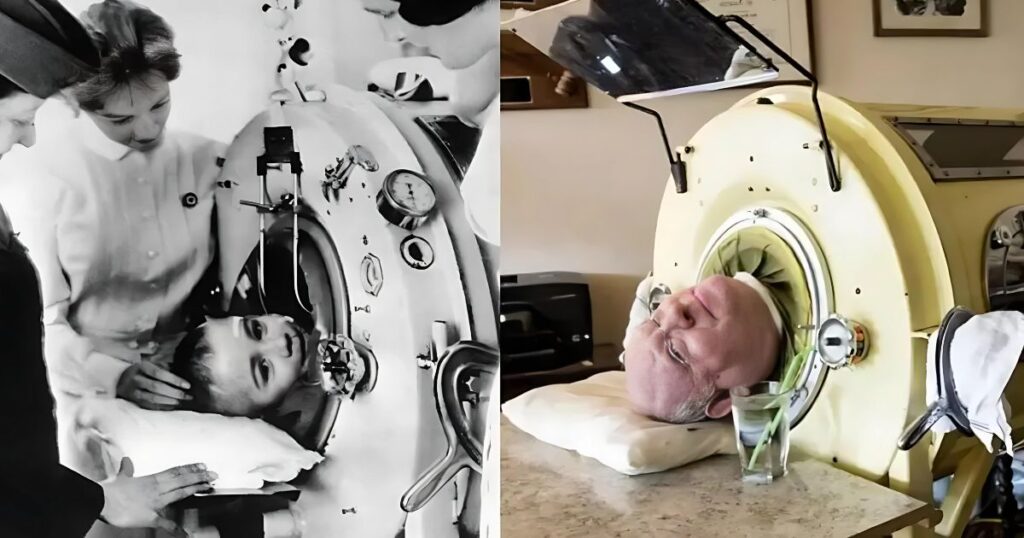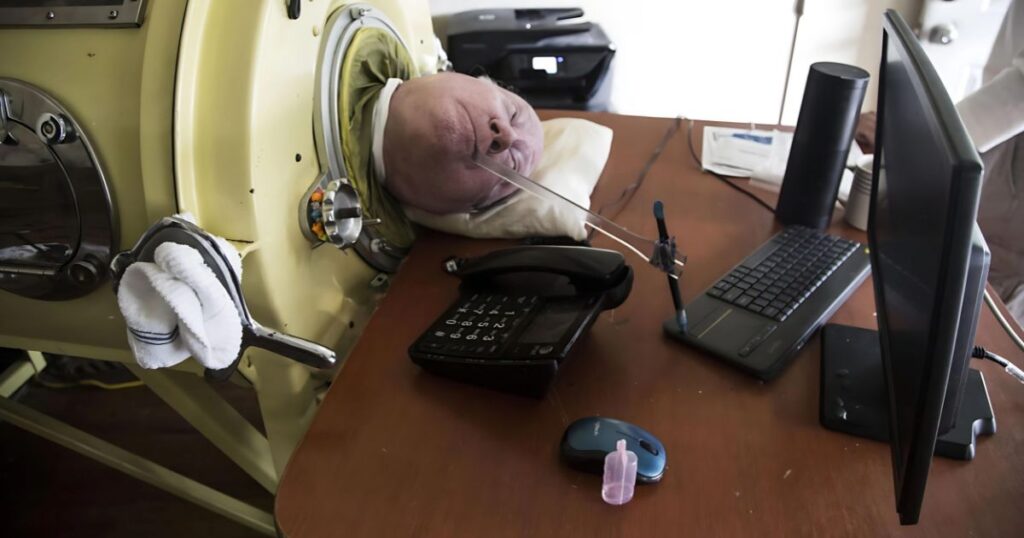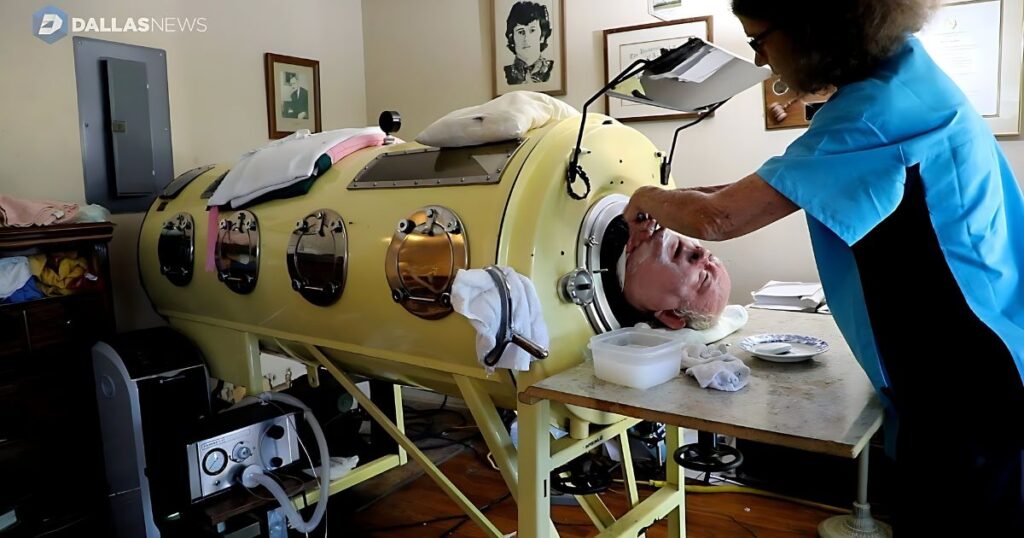A Life of Resilience and Inspiration
Paul Alexander, a remarkable individual whose life was forever altered by the devastating effects of polio, has passed away at the age of 78. His unwavering spirit and determination in the face of adversity have left an indelible mark on countless lives, inspiring future generations.
Read More: Digital News Planet
Paul Alexander: The Polio Epidemic and the Iron Lung
In 1952, when Paul Alexander was just six years old, he fell victim to the polio epidemic that swept across the nation.
Alexander contracted polio during the worst years of the U.S. outbreak, a time when hospital wards held row after row of children lying in iron lungs — seven-foot-long cylinders that use negative pressure and bellows to draw air into their lungs.
The disease progressed quickly in Alexander, shutting his young body down in a matter of days. He survived thanks to a last-minute tracheotomy; from there, he set out to push beyond the limits of his condition. Holding a rod in his mouth, he was able to turn pages in books and create art. He went to high school, college, and law school, and later in life, he used a rod to type words on a keyboard to write his autobiography.

The debilitating disease left him paralyzed and unable to breathe independently, forcing him to rely on an iron lung. This cumbersome yet life-sustaining machine became his constant companion.
The iron lung, a cylindrical tank that encased his body, utilized negative pressure to assist with respiration, allowing Paul Alexander to breathe and sustain his existence.
A Childhood Interrupted, a Life Transformed
Born in a small town in the Midwest, Paul Alexander’s childhood was abruptly interrupted by the polio outbreak that robbed him of the ability to breathe independently. Yet, despite such adversity, he remained undeterred, determined to forge a life of purpose and significance.

Advocating for Inclusivity and Accessibility
Paul Alexander became a vocal advocate for those living with disabilities. He championed the rights of individuals with physical limitations, tirelessly campaigning for accessibility and inclusivity in all aspects of society. His efforts inspired countless others to embrace their challenges and strive for independence.
Education and Career: Defying Limitations
Despite his difficulties, Paul Alexander enthusiastically pursued education, earning multiple degrees through correspondence courses and distance learning programs. His intellect and determination knew no bounds, and he went on to forge a successful career as a writer and motivational speaker, inspiring audiences worldwide with his remarkable story of resilience.
Life Confined to the Iron Lung
For most of his life, Paul Alexander could not leave the iron lung that encased his body and assisted his breathing after being paralyzed by polio at age 6 in 1952. Rarely seen outside the iron lung, this medical device circumscribed his existence.

A Full Life Despite Limitations
Yet Paul Alexander’s age and physical constraints did not prevent him from living a rich life. He pursued education, becoming a writer and speaker. Details in his obituary celebrate how he defied expectations.
Marriage and Family
While confined to the iron lung, Paul Alexander found love and companionship. He was married and had a family, shattering perceptions of what was possible with his disability.
Paul Alexander Death
Paul Alexander, whose life was an inspiring tale of resilience, is no longer still alive after his death at the age of 78. He left the iron lung that sustained him for over seven decades behind.
A Legacy of Hope and Inspiration
Paul Alexander’s life was a testament to the indomitable human spirit. It showcased how, even in the face of seemingly insurmountable obstacles, one can transcend limitations and leave an indelible mark on the world. His unwavering commitment to empowering others and advocating for inclusivity will forever serve as a beacon of hope and inspiration.
As we bid farewell to this extraordinary individual, we are reminded of the profound impact a single life can have on those around us. Paul Alexander’s legacy will endure, serving as a potent reminder that true strength lies not in physical ability but in the unyielding determination of the human spirit.
FAQs:
1: Why is Paul Alexander still in an iron lung?
Paul Alexander was paralyzed by polio as a child in 1952, leaving him unable to breathe on his own. The iron lung used negative pressure to artificially move air into and out of his lungs, allowing him to breathe and stay alive. He relied on it for over 70 years.
2: How did Paul Alexander go to college?
Since he was confined to the iron lung, Paul Alexander pursued his education through correspondence courses and distance learning programs over many years. His determination allowed him to earn multiple degrees despite his limitations.
3: What is the longest time someone has been in an iron lung?
Paul Alexander spent over 70 years in an iron lung, which is one of the longest stretches anyone has continuously relied on the machine. The iron lung became a literal part of his life after contracting polio.
4: Is there an alternative to an iron lung?
Yes, positive pressure ventilators are now more commonly used as an alternative to the damaging pressure of iron lungs. However, iron lungs were crucial life-saving devices for polio victims before modern ventilators existed.
5: Are iron lungs permanent?
Iron lungs were a permanent solution for many polio survivors who needed assistance breathing before positive pressure ventilators. People like Paul Alexander relied on them permanently once paralytic effects took hold.
6: How much does an iron lung cost?
In their heyday, iron lungs could cost thousands of dollars. An iron lung manufactured in the 1930s-1950s might equate to $30,000-$50,000 or more in today’s money.
7: What are iron lungs called today?
While not commonly used today, an iron lung is still technically referred to by the same name. More modern references might call them negative pressure ventilators or cuirass ventilators.
8: How many people are left in an iron lung?
With the polio vaccine and modern ventilators, iron lung usage dwindled. By the early 2000s, estimates suggested only 8-10 people in the U.S. still used iron lungs full-time.
9: Is Iron Lung worth it?
For polio survivors unable to breathe independently before modern ventilators, iron lungs were worth using as life-saving, life-sustaining devices despite their limitations.
10: Who designed the Iron Lung?
The first negative pressure ventilator prototypes were developed in the 1920s-1930s, with critical designs by Philip Drinker, Louis Agassiz Shaw, and James Wilson Robertson.
11: Can you survive Iron Lung?
Yes, iron lungs allowed polio victims with respiratory muscle paralysis to have their breathing artificially assisted and survive despite being confined to large metal chambers.
12: What type of horror is Iron Lung?
This likely refers to a 1989 horror novel by Stephen Gallagher about a man waking up trapped in an iron lung without explanation – a claustrophobic horror premise.
13: Who is the girl in the iron lung?
This could reference Martha Mason, who contracted polio in 1948 at age 11 and spent over 60 years in an iron lung before she died in 2009 at age 72.
14: Who was the woman in the iron lung?
In addition to Martha Mason mentioned above, Rose Hauer was another woman who relied on an iron lung for decades after contracting polio.
15: Who was the man living in the iron lung for 70 years?
This refers to Paul Alexander himself, who spent over 70 years confined to an iron lung after being paralyzed by polio as a child in 1952.
16: How do you eat in an iron lung?
People living in iron lungs had to eat and drink while horizontal. Food was placed on a tray near their mouths, allowing them to turn their heads to eat bite by bite.
17: Can polio be cured?
There is no treatment for polio; vaccination can only prevent the disease. However, the paralytic effects can be managed with medical support like ventilators.
18: Do people still get polio?
Thanks to the polio vaccine, poliovirus transmission has been eliminated in most countries. However, it persists in a few regions, and unvaccinated people remain at risk.





